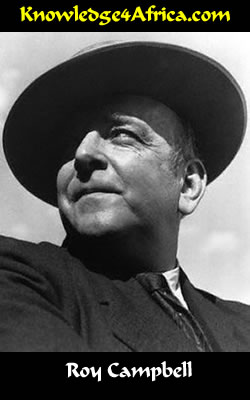|
READ THIS
Campbell's poem is a tribute to autumn and winter as a time, not of death, but of purifying and
transformation.
He looks forward to the migrating of the geese, seeing the trees lose their leaves and enjoying olive oil
and wine, the fruits of summer, in front of a fire made of the dead branches of the olive trees and vines.
 ABOUT THE POET
ABOUT THE POET
Roy Campbell was born in Durban in 1901 and was at one stage considered to be one of South Africa's
best poets. His popularity, however, has waned in recent years so that today his poetry is hardly ever
read.
Educated at Durban High School, he spent much of his youth in the great outdoors -- something that is
reflected in many of his poems like "The Zebras" and "Autumn". As soon as the Great War
was over, however, he moved to England where he attended Oxford University.
He married Mary Garman, a marriage which did not carry his parents' consent and therefore meant that,
for a time at least, Campbell was struck off from his inheritance. He had two daughters by this marriage.
In 1925, he returned to South Africa and founded a literary magazine called Voorslag which was
meant to promote cultural development amongst the Afrikaners whom the poet regarded as backward and
uncouth.
Very soon disillusionment set in, however, and he returned to England. His disillusionment continued even
there as he fell foul of his own fellow poets because of the many rude things he said about them in his
poems -- and even of his wife whom he found was not averse to lesbian affairs.
During the early 1930s he settled in the Provence region of France -- the scene for one of his greatest
poems, "Horses on the Camargue". During this time he was slowly drawn to Catholicism and
drunkenness.
In the mid-1930s, due to a loss in a civil lawsuit, the Campbell family fled to Spain where the poet became
an avid supporter of the fascist dictator, General Franco.
He also supported Adolph Hitler and Benito Mussolini. This support saw the poet's reputation slump even
further amongst his literary colleagues.
When World War II broke out, the poet moved back to England and enlisted for military duty. It was
during those years that he became close friends with the Welsh poet and fellow drunkard, Dylan Thomas.
After the war, the poet returned to the Iberian Peninsula but this time settled in Portugal. He died in a car
accident over the Easter weekend of 1957.
Have you looked at the questions
in the right column?
|
TEST YOURSELF!
Read the left column and then answer
the following questions:
"I love to see, when leaves depart,
The clear anatomy arrive,
Winter, the paragon of art,
That kills all forms of life and feeling
Save what is pure and will survive."
- Examine the PARADOX in this first stanza. (6)

[Need help?]
A PARADOX is a statement which at first appears to be contradictory, but on closer inspection makes
sense.
Autumn and winter are associated with ageing, death and dying. It is the time of year when nature
appears to lose its traditional beauty: flowers die, leaves fall from the trees, leaving them bare and
exposed to the elements. When someone is in the autumn of his life, we imply that he has passed his
prime and is heading for old age.
Campbell, however, sees positives in this process of ageing and dying. The falling of the leaves means
that the beautiful and impressive structure of the trees -- the trunks and branches -- is revealed.
Everything old and weak is eradicated, ensuring the survival of the fittest.
The result is that only the strong, dominant and resilient aspects are maintained. In this way, nature will
never be weakened. The cycle of life will remain strong with the spring renewal.
|
"And the dark pines, their own revealing,
Let in the needles of the noon."
- Identify the figures of speech in these two lines and discuss their contribution to the poem as a
whole. (5)

[Need help?]
By means of the phrase "their own revealing", Campbell maintains the use of PERSONIFICATION
which he introduced in stanza one with the word "anatomy".
The thin rays of the noon sun are compared with needles. After the lush growth of summer, when the sun
was not able to penetrate the forest, some of the pine needles have dropped, allowing the light from the
sun through, creating an atmospheric scene. The use of "needles" reveals that these are thin
slivers of sunlight that penetrate the forest.
There is also a PUN (a play on words). The leaves of pine trees are called needles because of their long,
thin shape. Campbell maintains the idea of continuation and positive feeling: the pine needles are
replaced by needle-shaped sun's rays.
|
"Stripped are the great sun-clouding planes."
- Discuss the effectiveness of the METAPHOR in the above line. (3)

[Need help?]
The great, leaf-filled canopies of the trees are compared with clouds that block out the sun.
The comparison is based not only on the blocking out of light, but also on shape: the round and uneven
shapes of the trees' canopies resemble the shapes of cloud. With the leaves having fallen, it is as though
a cloud has moved away from the sun.
|
"Strained by the gale the olives whiten
like hoary wrestlers bent with toil."
- Explain why Campbell has used this comparison. (4)

[Need help?]
The SIMILE compares the olive trees with wrestlers. Campbell uses this simile because, just as wrestlers
bend and strain against each other to subdue their opponents, the trees appear to be wrestling with the
gale-force wind.
The trees struggle to remain upright in the face of the gale which forces them to bend over, just as the
strength of a wrestler can subdue an opponent and force him to the floor.
There is also a similarity in colour: the undersides of the leaves of the olive trees are white, while the word
"hoary" means white-haired. The undersides of the leaves remind Campbell of heads of white hair.
It is a sign that, like a person with white hair, the olives have matured and are ready for picking.
An awareness of the effort involved is introduced by the word "strained", then continued with
"toil", which means "severe labour" or "to work laboriously or incessantly".
|
"To brim our vats where summer lingers."
- The word "brim" is NOT often used in association with autumn. Explain why not. Why has
Campbell chosen to use this word. (4)

[Need help?]
"To brim" means to be filled to the top. It implies abundance.
This is not an aspect usually associated with autumn, which traditionally refers to ageing; a dying down;
a depletion of life and energy.
Campbell uses the word to convey the fruitfulness of autumn. Without autumn we would not be able to
enjoy the fruits of summer: wine and olive oil.
|
"Soon on our hearth's reviving pyre
Their rotted stems will crumble up."
- Discuss how the comparison of the fire to a "pyre" reveals Campbell's attitude towards
autumn. (4)

[Need help?]
A "pyre" is a pile of wood usually associated with the burning of a dead body. It also has
connotations of resurrection and renewal.
For example, the phoenix was a mythical bird, the only one of its kind, which burned itself on a pyre and
then rose again from the ashes with renewed youth.
Campbell's use of this word continues the idea of the cycle of life: that autumn and winter are not only
about death, but also herald rejuvenation, vibrancy and energy. The dead, rotting wood from the vines
and olive trees is used to produce warm, comforting fires.
|
"Soon on our hearth's reviving pyre"
- By considering the connotations, comment on Campbell's decision to use the word
"hearth". (4)

[Need help?]
A "hearth" literally refers to the floor of a fireplace. Traditionally, it is where the food was cooked.
Centuries ago, the hearth used to be in the middle of the room. The family would sit around the fire,
cooking, eating and discussing the day's events. The word therefore has connotations of homeliness,
cosiness, warmth and family togetherness.
Its use in this poem enhances the pleasant image of someone relaxing beside a comforting fire, enjoying
a glass of wine.
|
"And like a ruby, panting fire,
The grape will redden on your fingers
Through the lit crystal of the cup."
- Comment on the effectiveness of the SIMILE and the PERSONIFICATION. (6)

[Need help?]
The colour of the wine in the glass is compared with a ruby -- a red precious stone. The colour is lively
and produces a feeling of warmth. The fire lights up the glass, resulting in the colour of the wine being
reflected on the fingers holding the glass. The colour of the wine sparkles through the crystal glass.
The image of "panting fire" is both a continuation of the simile and an example of personification.
The "panting" refers to the movement of the wine's reflection. The reflection is not static because
the glass is lit up by the moving flames from the fire in the hearth, causing the reflection to look as though
it is breathing.
|
"Soon on our hearth's reviving pyre
Their rotted stems will crumble up:
And like a ruby, panting fire,
The grape will redden on your fingers
Through the lit crystal of the cup."
- Identify the mood of this last stanza and discuss how Campbell has succeeded in achieving
it. (6)

[Need help?]
The mood is one of satisfaction, warmth, comfort and cosiness.
This is initially established by the fire producing a warm glow. The satisfaction comes from the use of the
dead wood to produce this fire, with the knowledge that nothing has gone to waste, but is utilised to
produce something positive. It provides comfort against the cold outside.
It is a stanza which appeals to the senses. There is the sight of the moving flames, the crackling sound
and smell of the fire, and the feeling of warmth that it produces. There is also the colour, smell and taste
of the wine in the crystal glass. The stanza elicits a sense of pleasure and well-being.
|
Each stanza in this poem contains a contrast. Discuss Campbell's reasons for using this
structure. (5)

[Need help?]
Each stanza has a negative, balanced by a positive aspect: out of the negative, something positive flows.
Campbell uses this to imitate the cycle of life. He reminds us that there has to be balance in life: in order
to appreciate the good, there has to be some bad; in order for life to be renewed, something has to be
sacrificed.
The fallen leaves reveal the beautiful shapes of the trees and allow sunlight to penetrate the dark forest
to ensure the rejuvenation of the forest; the onslaught of the gale-force wind signals the time to pick the
olives and grapes; the dead wood is used to build a life-giving fire.
There is always something to look forward to when one aspect comes to an end. The poem celebrates
autumn and the interdependence of the seasons. It shows how one thing can be transformed into
another: grapes into wine and olives into olive oil.
|
|



